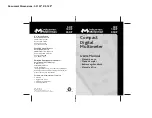
Theory of
Operation—DM 5010
At the
beginning of a conversion, an Auto-Zero period is
initiated
in which a zero-reference voltage is stored by the
converter. This voltage is
compared to the output of the
integrator during actual signal measurement
and represents
a zero-volt input.
After
the
zero reference has
been established, the input
current
is switched
into the node. This current
and l^^^
cause
the integrators output to
integrate
up toward
the
zero-reference voltage at
a
rate determined by
+
I*,.
For input
voltages
< the full scale voltage, the integrator
output will cross the zero-reference voltage
in less than four
measurement
intervals.
After the zero-reference voltage
crossing and a new polarity determination is made, the con
trol
logic
switches the reference current’s direction (and thus
the
direction of
integration).
The
measurement interval consists of 18 clock cycles,
which
allow the integrators
output
to charge
somewhat
be
yond the zero-reference voltage before charge direction
is
reversed. During this charging process, each clock is added
to
or
subtracted
from the contents of a
counter depending
on
the output
state of the comparator.
The integrators output now
charges
back toward the
zero-reference
at
a
rate determined by
+
l^ It may
take less
than one or up to several hundred measurement
intervals for the
integrator output to again cross
the zero
reference
voltage.
After the comparator detects the cross
ing
and a new polarity determination is made, charge
direction
is
reversed at the beginning of the next measure
ment interval.
This
process of charging toward the thresh
old, beyond
the threshold,
and
then reversing direction to
charge back toward the
threshold repeats until
the pre
scribed
number of measurement intervals is complete. Dur
ing this time, the
accumulated count
in the up/down counter
is
being added
to or
subtracted from, depending on the out
put state
of
the
comparator (ICOMP).
When the last mea
surement interval is complete, the accumulated clocks in the
counter
are representative of the A/D converters input.
Microprocessor
The implementation of a microprocessor in the DM
5010
substantially
reduces its hardware requirements
and in
creases
its flexibility and capability. Microprocessor sys
tems
use bus-structured
architecture. A general
description
follows.
ing information, “locations’ of certain information, etc. Of
these
types of
information, most
are stored (at
least tempo
rarily)
in the form of “data" at an “address" or as some type
of
control signal or
level.
The
microprocessor uses
busses to control the flow of
data
and
program execution. A bus is a group of signal lines
dedicated
to
a data transfer or
program control function.
It
is
connected
to allow bidirectional data transfer or control
over
two
or more devices using the same signal
paths for
any
two of the
transfers or
control
functions.
The
data bus is the group of
eight signal lines in the
DM
5010,
dedicated to transferring data in a standard for
mat
between the
microprocessor
and the other devices on
the bus.
The
address bus is another group of signal lines dedi
cated
solely to
“addressing" (selecting) the device that the
microprocessor
wants
to communicate with (data transfer
via
the
data bus). Address-decoding circuitry makes the de
vices
on the data bus respond only
to their proper
address(es).
The
remaining lines associated directly with the micro
processor IC
(with the exception of power supply and clock
signals)
comprise
the
control
bus. These signal
lines allow
the
processor to
control certain system functions
and allow
certain
conditions within the system
to alter processor
operation.
The bus
configuration employed in processor-oriented
systems allows great flexibility
when implementing hard
ware.
Since system operation is under “firmware’ control,
functions
that normally require large amounts of dedicated
circuitry
may be performed by a general block operating in
several
different
modes.
Another
characteristic of processor-oriented
systems is
the
ability to perform calculations. Some parameters may
not
be measured directly with
a multimeter, and a series of
calculations must be performed to arrive at the desired re
sult.
The DM 5010 has
the capability of performing some
frequently
used calculations, giving the user the ability to
“directly"
measure these parameters.
At
any given
time
in a microprocessor system, many
‘pieces’ of information may be present at various physical
locations
within the system. This information may include
the
instructions for the
microprocessor to perform
some
process,
constants and algorithms for that process, inter
mediate
and final results for the process, control and switch
GPIB
The GPIB
(General Purpose Interface Bus) circuitry of
the
DM 5010 provides a communication link to other
GPIB
compatible
instruments.
This communication link allows the
DM
5010 to
be programmed to operate in any of its
mea
surement
modes
and then to transfer the results of that
4-2
ADD
JAN
1982
Summary of Contents for DM 5010
Page 14: ...DM 5010 2994 00 DM 5010 Programmable Digital Multimeter xii ADD JUL 1986...
Page 27: ...Operating Instructions DM 5010 2994 03 Fig 2 3 DM 5010 front panel controls and connectors 2 3...
Page 38: ......
Page 134: ......
Page 208: ......
Page 222: ......
Page 250: ......
Page 251: ...Section 8 DM 5010 OPTIONS No options are available 8 1...
Page 252: ......
Page 270: ......
Page 272: ...DM 5010 2994 37 Fig 10 2 Location of DM 5010 adjustments and test points...
Page 273: ......
Page 274: ......
Page 275: ......
Page 276: ...DM 5010 2994 112 DM 5010 BLOCK DIAGRAM...
Page 281: ......
Page 282: ......
Page 291: ......
Page 293: ......
Page 294: ......
Page 297: ......
Page 298: ......
Page 303: ......
Page 304: ...I...
Page 305: ......
Page 310: ......
Page 311: ......
Page 315: ......
Page 318: ......
Page 321: ......
Page 323: ......
Page 326: ......
Page 332: ...2994 57...
Page 334: ......
Page 335: ......
Page 336: ......
Page 337: ...63 REV JUN 1986...
Page 338: ...FIG 1 EXPLODED DM 5010...
Page 339: ......
Page 340: ......
Page 341: ......
Page 347: ......
















































